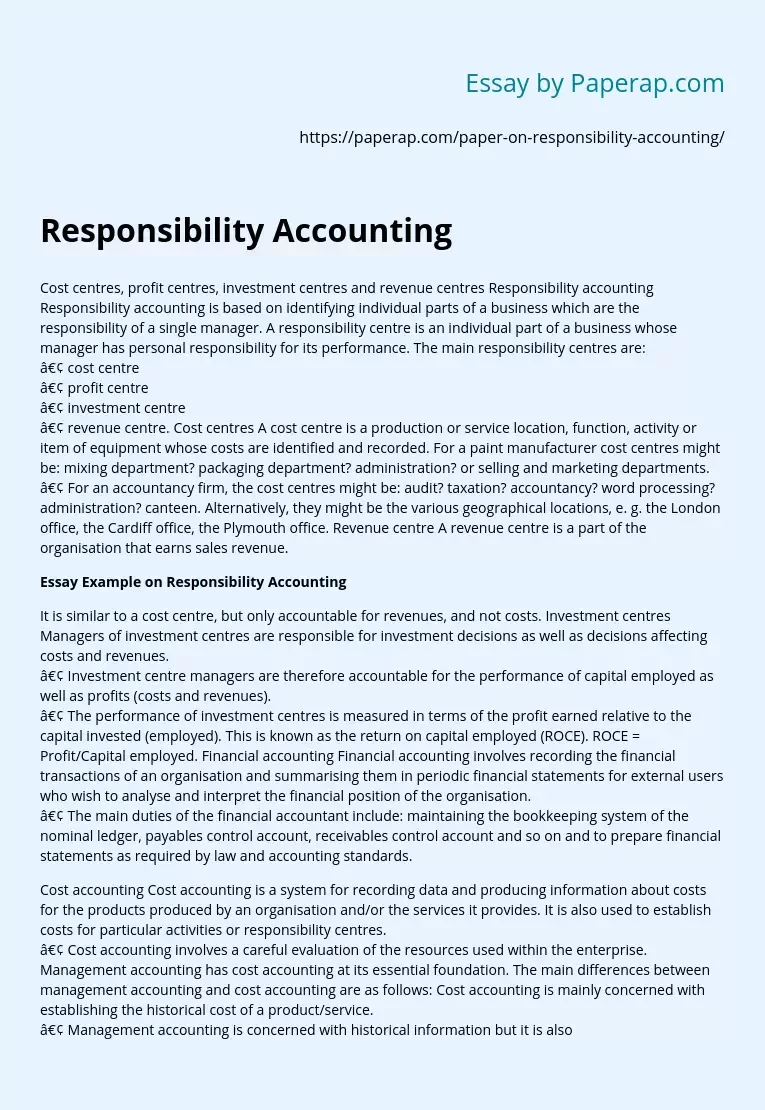Responsibility Accounting
Cost centres, profit centres, investment centres and revenue centres Responsibility accounting Responsibility accounting is based on identifying individual parts of a business which are the responsibility of a single manager. A responsibility centre is an individual part of a business whose manager has personal responsibility for its performance. The main responsibility centres are:
• cost centre
• profit centre
• investment centre
• revenue centre. Cost centres A cost centre is a production or service location, function, activity or item of equipment whose costs are identified and recorded.
For a paint manufacturer cost centres might be: mixing department? packaging department? administration? or selling and marketing departments.
• For an accountancy firm, the cost centres might be: audit? taxation? accountancy? word processing? administration? canteen. Alternatively, they might be the various geographical locations, e. g. the London office, the Cardiff office, the Plymouth office. Revenue centre A revenue centre is a part of the organisation that earns sales revenue.
Essay Example on Responsibility Accounting
It is similar to a cost centre, but only accountable for revenues, and not costs.
Investment centres Managers of investment centres are responsible for investment decisions as well as decisions affecting costs and revenues.
• Investment centre managers are therefore accountable for the performance of capital employed as well as profits (costs and revenues).
• The performance of investment centres is measured in terms of the profit earned relative to the capital invested (employed). This is known as the return on capital employed (ROCE). ROCE = Profit/Capital employed. Financial accounting Financial accounting involves recording the financial transactions of an organisation and summarising them in periodic financial statements for external users who wish to analyse and interpret the financial position of the organisation.
• The main duties of the financial accountant include: maintaining the bookkeeping system of the nominal ledger, payables control account, receivables control account and so on and to prepare financial statements as required by law and accounting standards.
Cost accounting Cost accounting is a system for recording data and producing information about costs for the products produced by an organisation and/or the services it provides. It is also used to establish costs for particular activities or responsibility centres.
• Cost accounting involves a careful evaluation of the resources used within the enterprise. Management accounting has cost accounting at its essential foundation. The main differences between management accounting and cost accounting are as follows: Cost accounting is mainly concerned with establishing the historical cost of a product/service.
• Management accounting is concerned with historical information but it is also forwardlooking. It is concerned with both historical and future costs of products/services. (For example, budgets and forecasts).
• Management accounting is also concerned with providing nonfinancial information to managers.
• Management accounting is essentially concerned with offering advice to management based upon information collected (management information). Management accounting may include involvement in planning, decision making and control. The following illustration compares management accounting with financial accounting. Management accounting Financial accounting Information mainly produced for Internal use: e. g. managers and employees External use: e. g. shareholders, creditors, lenders, banks, government. Purpose of information To aid planning, controlling and decision making To record the financial performance in a period and the financial position at the end of that period. Legal requirements
None Limited companies must produce financial accounts. Formats Management decide on the information they require and the most useful way of presenting it Format and content of financial accounts intending to give a true and fair view should follow accounting standards and company law. Nature of information Financial and nonfinancial. Mostly financial. Time period Historical and forwardlooking. Mainly an historical record. chapter 1 Information mainly produced forInternal use: e. g. managers and employees External use: e. g. shareholders, creditors, lenders, banks, government. KAPLAN
Responsibility Accounting. (2019, Nov 27). Retrieved from https://paperap.com/paper-on-responsibility-accounting/

